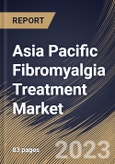Fibromyalgia (FM) is a somatization illness characterized by widespread, persistent musculoskeletal pain in addition to impacting the patient's quality of life. The symptoms also affect the patient's emotional condition because the only indication of the sickness is a pain in the whole body. Among the functional issues that frequently coexist with FM are depression, panic attacks, irritable bowel syndrome, chronic fatigue syndrome, anxiety, and post-traumatic stress disorder. Fibromyalgia is commonly categorized as a pain control disorder because it is a central sensitization problem.
FM is believed to be caused by sensitization, which encompasses systemic symptoms including cognitive decline, sleep issues, anxiety, tiredness, and depressive episodes, as well as central sensitivity syndromes like joint stiffness and chronic pain at multiple painful places. Many ailments, including infections, mental or neurological disorders, diabetes, and rheumatic pathologies, are usually connected to FM. Moreover, despite proof for a specific candidate gene, numerous studies have suggested a genetic predisposition for fibromyalgia.
The remarkable rise in human longevity throughout the 20th century has manifested in the region phenomenon of population aging. India's population over 60 has more than quadrupled in the past 50 years. According to the 2011 census, the number of elderly persons (60+ years) was 103.83 million; this number is expected to rise to 133.32 million in 2021, 178.59 million in 2031, 236.01 million in 2041, and 300.96 million in 2051. Considering that musculoskeletal disorders like fibromyalgia are typically more prevalent in the elderly, the growing geriatric population and the government's approach to ensuring the welfare of the elderly will increase the demand and purchasing power of the population in the region, thereby driving market growth in APAC.
The China market dominated the Asia Pacific Fibromyalgia Treatment Market by Country in 2022, and would continue to be a dominant market till 2030; thereby, achieving a market value of $302.6 million by 2030. The Japan market is exhibiting a CAGR of 4.5% during (2023-2030). Additionally, The India market would register a CAGR of 5.8% during (2023-2030).
Based on Drug Class, the market is segmented into Anticonvulsants, Antidepressants, Muscle Relaxants and Others. Based on Distribution Channel, the market is segmented into Drug stores & Retail Pharmacies, Hospital Pharmacies and Online Providers. Based on countries, the market is segmented into China, Japan, India, South Korea, Singapore, Malaysia, and Rest of Asia Pacific.
The market research report covers the analysis of key stake holders of the market. Key companies profiled in the report include AbbVie, Inc., Novartis AG, Eli Lilly And Company, Amneal Pharmaceuticals, Inc., Teva Pharmaceuticals Industries Ltd., Zydus Lifesciences Ltd., Lupin Limited, Abbott Laboratories, Viatris, Inc., and Sun Pharmaceutical Industries Ltd.
Scope of the Study
By Drug Class
- Anticonvulsants
- Antidepressants
- Muscle Relaxants
- Others
By Distribution Channel
- Drug stores & Retail Pharmacies
- Hospital Pharmacies
- Online Providers
By Country
- China
- Japan
- India
- South Korea
- Singapore
- Malaysia
- Rest of Asia Pacific
Key Market Players
List of Companies Profiled in the Report:
- AbbVie, Inc.
- Novartis AG
- Eli Lilly And Company
- Amneal Pharmaceuticals, Inc.
- Teva Pharmaceuticals Industries Ltd.
- Zydus Lifesciences Ltd.
- Lupin Limited
- Abbott Laboratories
- Viatris, Inc.
- Sun Pharmaceutical Industries Ltd.
Unique Offerings
- Exhaustive coverage
- The highest number of Market tables and figures
- Subscription-based model available
- Guaranteed best price
- Assured post sales research support with 10% customization free
Table of Contents
Companies Mentioned
- AbbVie, Inc.
- Novartis AG
- Eli Lilly And Company
- Amneal Pharmaceuticals, Inc.
- Teva Pharmaceuticals Industries Ltd.
- Zydus Lifesciences Ltd.
- Lupin Limited
- Abbott Laboratories
- Viatris, Inc.
- Sun Pharmaceutical Industries Ltd.
Methodology

LOADING...








